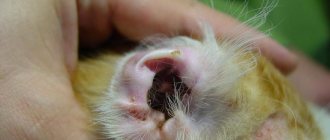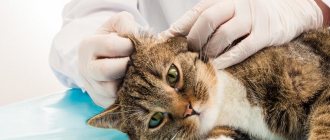In terms of the number of infections among cats, the subcutaneous mite or demodex mite is second only to fleas. It causes a disease called demodicosis, which in turn comes in two types: localized and generalized. The first type involves infection of one area on the body (for example, ears, eyes, withers, etc.), while with the second type, several areas of the skin are affected.
If even minor symptoms of demodicosis are detected, you should immediately seek help from a veterinarian.
Types of diseases caused by subcutaneous mites
- Actually demodicosis. Develops due to inflammation, which is provoked by waste products of microorganisms. Manifests itself in the form of external damage to the skin and hair.
- Ear scabies is the most common type of demodicosis. Formed when the parasite enters the ear or lymph nodes in this area. It contains many nutrients for mites: skin tissue, earwax, dandruff and other formations. If an animal is affected by a disease, then black dirt appears in the ears, which is the waste products of microorganisms and congealed blood. The main sign of pathology is an unpleasant putrid odor.
Risk group
Almost any animal can become infected with demodicosis. Even home maintenance and proper care do not guarantee complete safety. And under certain circumstances, the risk of infection increases.
Cats that do not receive appropriate care are more susceptible to mite infestation. Unsanitary conditions favor the proliferation of parasites. Animals with a weakened immune system, elderly cats with reduced protective function of the skin, as well as with incompletely treated chronic pathologies are more susceptible to demodicosis, and the disease itself in this case is characterized by a rapid course.
Description of the disease
Demodectic blepharitis is a chronic disease that occurs with periods of exacerbations and remissions. When the edges of the eyelids become inflamed (blepharitis), favorable conditions are created for the life and reproduction of mites of the genus Demodex, which in turn aggravates the clinical course of the disease.
In 1841, the first mentions of a parasite with an interesting name - Demodex - appeared in the literature. Scientists have found it on the skin in acne, as well as in earwax. It was then that the name Demodex was coined (from the Greek Demo - lard, Dex - worm). Only two subtypes have been found on human skin: Demodex folliculorum and Demodexbrevis.
According to modern domestic researchers in the Russian Federation, parasite carriage (i.e. the presence of this mite in the skin) is observed in 100% of cases in patients over 60 years of age and in 50% of younger people.
Causes and routes of infection
Demodectic mange in pets can develop under the influence of the following sources:
- worms and intoxication caused by waste products of these parasites;
- weakened immune system;
- improper and unbalanced diet;
- lack of vitamins A, E and B;
- keeping your pet in damp, dirty conditions.
Demodectic mange can be transmitted through contact between a cat and another infected animal or from the mother to a kitten. In some situations, the baby may be infected during intrauterine development. The length of the incubation period depends on the state of the animal's immune system.
Symptoms of demodicosis
Localization of demodex is most often noted in the abdomen, withers, ears, muzzle and tail. The parasite can multiply and live on a cat for quite a long time, while the disease itself will not manifest itself. When an animal's immunity decreases, the following symptoms are observed:
- deterioration in the appearance of fur;
- the appearance of peeling in the eye area;
- damage to skin pigmentation;
- detection of dandruff throughout the fur;
- hair loss in some areas;
- acne formation;
- due to itching and discomfort, the pet itches all the time, scratching the damaged skin until it bleeds;
- a hardened crust up to 2–12 mm high forms in the infected area;
- ichor is released on the growth;
- bald areas become covered with small ulcers and acquire a pearlescent hue.
Such symptoms appear due to the constant movement of the parasite across the skin, which leaves its waste products on it. To see demodex, the balding areas need to be gathered into a fold. The found parasite and the pet itself should be immediately taken to a veterinary hospital for diagnosis and appropriate therapy.
Also read the article about eye diseases in cats so as not to confuse their symptoms with demodicosis.
Types of disease
To make sure the diagnosis is correct, the veterinarian will take a scraping from the cat. Using a scalpel, he will collect pieces of skin in several places. As a result, if the diagnosis is confirmed and the cat is infected, the study will show a certain number of parasites.
Animal demodicosis can manifest itself in varying degrees of severity. To suspect a problem, it is enough to focus on general signs, and only a doctor can provide more accurate information.
Symptoms also depend on the specific type of demodicosis. There are only 3 known:
- Localized. This is the mildest stage. At this stage, redness of the cat’s skin and peeling in the affected areas are noted. Additionally, pustules appear as the skin loses some of its healing properties. The number of affected areas is small and after 1-2 months demodicosis goes away on its own and does not require treatment.
- Generalized. This is a more severe type of disease. During its course, extensive affected areas are observed. The places where the mite is localized are itchy and cause discomfort to the cat. This species is also characterized by bleeding wounds, pustules, and peeling. First, demodicosis appears on the head and neck, then moves to the limbs and back. The lesions tend to merge together and form one large wound.
- Juvenile. The most dangerous and unpredictable type. Appears in cats with a hereditary predisposition to the disease. It is difficult to treat, occurs with complications, and almost completely destroys the body’s defense system.
Demodectic mange in cats
Demodectic mange can also be:
- Primary. When the disease manifests itself after the first contact with the parasite.
- Secondary. In this case, the disease occurs as a consequence of a skin disease and reduced immunity.
Important!
An accurate diagnosis can only be made after receiving the scraping result. Demodicosis has similar symptoms to skin fungus, eczema, pyoderma, ringworm and streptococcosis.
Methods for treating demodicosis in cats
Removing demodex from cats is quite difficult. Initially, it is recommended to bathe your pet with Doctor or Elite shampoos. The purpose of the procedure is to cleanse the skin of suppuration, dandruff and lymph. Afterwards, you need to disinfect the damaged areas with Chlorhexidine or hydrogen peroxide. And when the skin dries, proceed to the main treatment: the use of external medications - for mild cases of the disease - or injections - for severe cases.
In the absence of help for the pet, the parasite begins to lay larvae. Particularly serious cases can lead to the death of the cat.
Medicines and injections
When an animal is initially infected, it is quite difficult to decide on the choice of drugs to eliminate parasites. Each type of disease requires its own medications to treat, so it is best to seek help from a veterinarian.
Localized demodicosis
In this case, damage to small areas of the skin is observed. Only a veterinarian selects the drug and can prescribe ointments, shampoos and sprays. Basically, the doctor prescribes the following medications:
- Sulfur or aversectin ointments;
- Unoiled;
- Tsidem;
- Liniment Demos;
- Amit;
- Ivermek-gel.
Do not forget that the products are applied to skin cleansed of hair.
The pet also needs medications to boost its immunity. Usually prescribed:
- Gamavit;
- Immunoparasite;
- Gala Vet;
- Maxidin.
Generalized demodicosis
This type of disease is more difficult to treat because all of the pet’s skin is damaged. Do not despair even if your animal develops ulcers and severe irritation - the disease can be overcome.
To better absorb the medication for external use, the cat should be trimmed and bathed with a special shampoo (Doctor VIC). Then the skin is soaked in sea buckthorn oil, and after it dries, the prescribed medication is treated.
If the disease is severe, injection solutions are prescribed:
- Cydectin – single dose – 0.4 ml;
- Dectomax - the dose is determined by the veterinarian taking into account the pet’s body weight.
The development of complications indicates the addition of a secondary infection. In such a situation, a course of antibiotics is prescribed:
- Betamox;
- Amosina;
- Amoxicillin;
- Kanamycin;
- Baytrila.
It is important for an animal to eat properly. You should include foods rich in vitamins and minerals in your diet.
Diagnosis of demodectic blepharitis
— Collection of complaints and information about the presence of chronic diseases; — Biomicroscopy—examination of the eyelids and ocular surface with a special device. Upon examination, the condition and quality of the tear film, meibomian gland ducts, and discharge in the eye cavity are determined; -Laboratory diagnostics - bacteriological examination of the microflora of the conjunctival cavity and determination of sensitivity to antibiotics may be required; — Microscopic examination for the presence of mites of the genus Demodex. At the same time, an acarogram is made (counting larvae, eggs and other forms of mites). The presence of a tick serves as an objective diagnostic criterion.
The presence of more than 4 live moving ticks confirms the diagnosis of demodectic blepharitis.
ethnoscience
The use of home remedies in the treatment of demodicosis is allowed only if the veterinarian has not found any restrictions. Moreover, such methods are not suitable for a generalized form of the disease. As folk remedies for eliminating subcutaneous mites, you can:
- Every day, bathe the animal with Doctor shampoo, and then wipe the damaged skin with a decoction of chamomile and sage. To prepare the drug, you need 1 tbsp. l. Pour 0.5 liters of hot water over each plant and cook for 10 minutes. Cool the liquid and warm it up slightly each time before use.
- Bathe your pet with tar soap, and then treat the infected areas with calendula tincture.
- Wipe areas where hair has fallen out twice a day with kerosene. After treatment, do not wash the cat for 2 days.
During the treatment process, it is important to disinfect the pet’s resting place and its belongings. All medications for external use must be warmed to room temperature.
It should be borne in mind that traditional methods can provoke intoxication and other serious consequences.
Demodicosis caused by Demodex gatoi
Demodex gatoi is another causative agent of demodicosis, but the subcutaneous mite looks different. The tick's body is wider and shorter. It parasitizes only the upper layers of the skin, without injuring the hair follicles.
Interesting fact! This type of demodicosis was recently identified. Previously, the disease was recorded in the United States of America, but due to active migration of the population and visits to international cat shows, the disease appeared in France, Russia and Great Britain. This fact is confirmed by the fact that the disease is found in rare elite breeds of cats.
Demodicosis, caused by Demodex gatoi, is considered contagious and can be transmitted through close contact between two individuals. That is why it is recommended to treat show animals against all ectoparasites a few days before an important event with a large crowd of cats, as well as before mating and giving birth.
Clinical signs
A characteristic symptom of the presence of the subcutaneous mite Demodex gatoi is alopecia and itching. Hair loss can be either focal or generalized (covering most of the body). In addition to slight peeling of the skin, there are no other pathological signs of skin damage. It looks like complete hair loss in a certain area of the body.
Itching in cats can manifest itself in different ways, from mild (the animal will lick the itchy areas more often) to intense (excessive licking, the formation of self-induced alopecia). The location of bald spots is varied and depends on which parts of the body the cat licks most often.
As symptoms increase, the following may appear:
- erythema (redness);
- dry dandruff, scab (a crust on a healing wound);
- hyperpigmentation of bald parts (more often in cats that walk outside).
Diagnostic methods
The main method for diagnosing demodicosis caused by Demodex gatoi is a superficial scraping, since the mite in a cat is localized in the stratum corneum of the skin. It is optimal to take scrapings from different affected areas.
Sometimes a cat may ingest ticks through intense licking, and they can be found in the feces (this method is rarely used).
In cases where a cat has obvious clinical signs of subcutaneous demodex mites, but no parasites are found in scrapings, the veterinarian will prescribe a trial diagnostic treatment for several days or weeks. Only after treatment is a diagnosis made.
It is not possible to determine the presence of subcutaneous ticks at home; it is better to do this in a veterinary laboratory.











